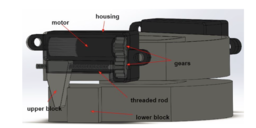Robotic Oral Appliance for Obstructive Sleep Apnea Management
TECHNOLOGY NUMBER: 7545

OVERVIEW
A mandibular advancement device that evaluates and improve sleep apnea symptoms- Dynamically senses and responds to obstructive sleep apnea symptoms
- Can remove or replace laboratory sleep studies required for MADs or CPAP
BACKGROUND
Obstructive sleep apnea (OSA) occurs when the muscles in the throat relax too much during Rapid Eye Movement (REM) sleep causing the back of the tongue to occlude the airway and interrupt sleep. This condition affects approximately 25 million people in the United States, and OSA patients can come to be at a heightened risk for multiple health issues such as elevated blood pressure, heart attack, stroke, and arrhythmias. Existing interventions may help to limit the effects of OSA, though each of these treatments may be poorly suited for individual patients.
For example, continuous positive airway pressure (CPAP) machines are a common intervention for those with OSA, yet this approach is limited by loud operation, a propensity for causing dehydration, and other uncomfortable physical feelings that can lead to poor patient compliance. Mandibular advancement devices (MADs) are a popular alternative to CPAPs which work by moving the mandible forward to help prevent airway occlusion. Unfortunately, the technology used in existing MADs holds the jaw in a static advanced position which causes jaw muscle soreness and undermines the goal for improving sleep quality. A need exists to improve the comfort and patient compliance of MADs interventions.
INNOVATION
University of Michigan researchers have developed a mandibular advancement device that dynamically senses and responds to obstructive sleep apnea symptoms while patients sleep. This technology is a robotic MAD that can detect OSA, dynamically advance the jaw to treat OSA symptoms, and relax the jaw when symptoms subside. The machine employs an actuator that uses a small brushed DC motor to drive a threaded rod, ultimately advancing the lower jaw. The prototype consists of two retainer trays on which the components of the actuator are mounted. Two motor gearboxes are mounted on the upper tray, one on either side of the jaw. Each motor gearbox contains a motor and gear that turns a threaded rod. The rod threads into and pulls forward a plastic post, called the upper block. The upper block then contacts a protruding lower block, which is part of the lower retainer tray. When the actuator is powered, the upper block pushes on the lower block, forcing the lower jaw to protrude forward. This invention is therefore designed to reduce the discomfort of traditional MADs and improve or replace the expensive lab sleep studies patients must go through to calibrate both traditional MADs and CPAP machines. As such, this device represents a significant improvement over conventional medical devices for the evaluation of and treatment for OSA.